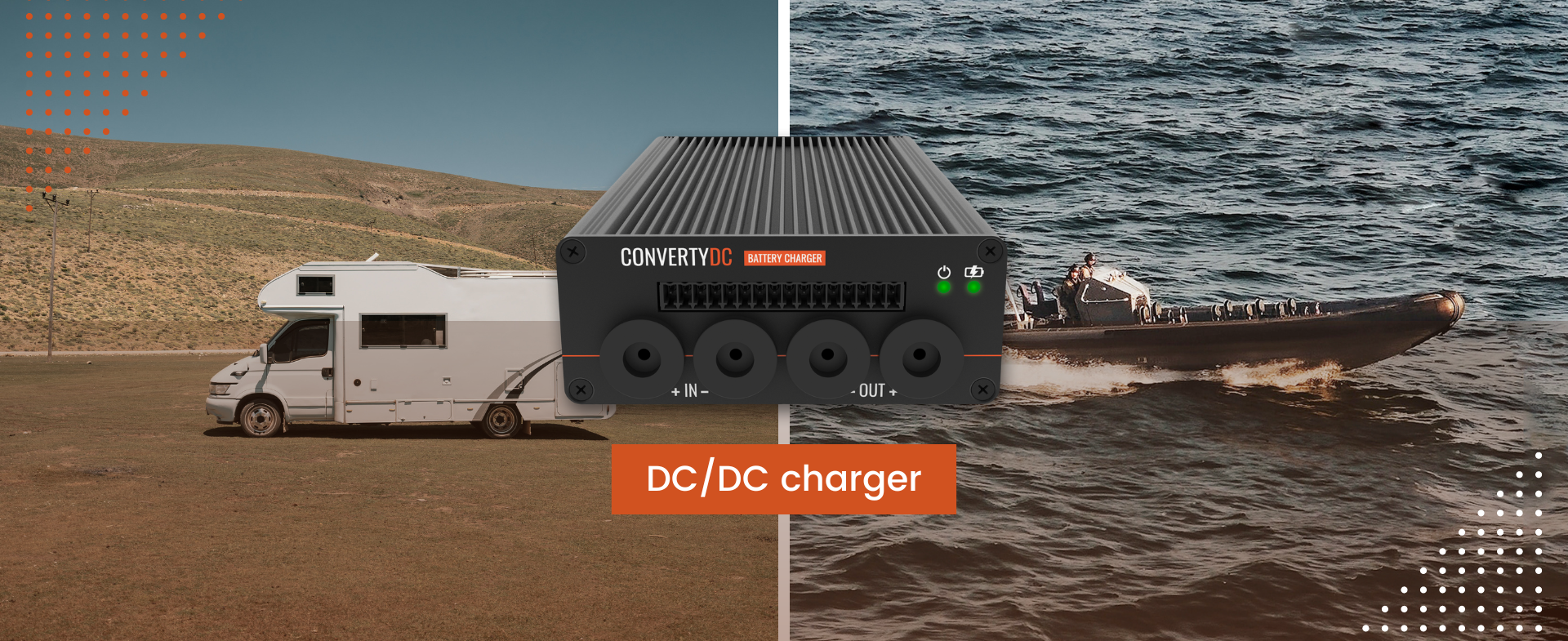The DC/DC charger has a significant function in the energy conversion on board a campervan, a boat or a professional utility vehicle.
In addition to recharging the auxiliary battery, it has a real impact on its performance and lifetime, regardless of its electrochemistry.
How does a DC/DC charger work?
The main function of the DC/DC charger is to recharge an on-board auxiliary battery in a vehicle with ancillary electrical and electronic equipment with a power requirement. This charging is done from any DC source such as an engine battery.
To do this, it uses 3 charging phases to transfer energy into the battery:
- Bulk phase: The battery is charged at constant current (maximum charge current) until the end-of-charge voltage is reached;
- Absorption phase: The battery is charged at a constant voltage with a gradually decreasing current to reach the full charge. A low minimum current can allow the cells of lithium batteries to be properly balanced;
- Floating phase: To ensure good battery life, the full charge voltage should not be maintained. The floating phase allows the voltage to be kept high enough to keep the battery charged without degrading it.

Why choosing a DC/DC charger for a lead-acid auxiliary battery
The limits of the splitter coupler
As the name suggests, the splitter coupler separates the engine battery from the auxiliary battery. Thanks to this separation, it ensures that the auxiliary battery can be charged from the engine battery while preserving both.
When the engine battery is charging, i.e. when the motorhome or boat is running, the separator coupler connects the two elements.
When the engine is switched off, when the voltage of the engine battery drops, the separator-coupler cuts this link in order to preserve the engine battery.
This electronic solution is most often used for lead-acid auxiliary batteries, which are less complex and less expensive. However, the use of a DC/DC charger is recommended to ensure a better charge of the auxiliary battery and a longer life.
The advantage of a DC/DC charger for a lead-acid auxiliary battery
The DC/DC charger goes further than a simple splitter coupler. It offers the advantage of being a real battery charger compared to the splitter coupler. It ensures a safer and more optimal charging of the auxiliary battery thanks to the Bulk/Absorption/Floating charge profiles.
Why choosing a DC/DC charger for a lithium auxiliary battery
The last few years have seen important developments in the battery sector. Lead-acid batteries, which were not very powerful, have progressively given way to lithium batteries (NMC, LTO, LFP, etc.) which are more powerful and have a higher energy density and a longer life span.
A necessity for good charge cycle management
Whether it is for a motor home, a boat or a professional vehicle, manufacturers are now more inclined to use lithium auxiliary batteries in order to benefit from their many advantages.
However, while these batteries are more efficient, one of the reasons for their rapid wear and tear is poor management of their charge and discharge cycles. The use of a DC/DC charger is therefore essential to optimise their life span thanks to adapted charging profiles.
Selfenergy®‘s DC Converters are designed with customised charging curves that take the form of two additional steps to provide a complete and safe charge:
- The acceptance phase: Before starting a high current charge, the Selfenergy® charger checks the battery for defects. The battery is charged at low current to allow the charger to check that the battery reacts correctly to this slow charge;
- The maintenance phase: After several days or if the charge voltage decreases, the DC Converty automatically restarts a Bulk-Absorption charge cycle to ensure that the auxiliary battery remains fully charged.
Connectivity to optimise the performance of the lithium battery
With more modern electronics and algorithmic developments, DC/DC chargers are becoming increasingly efficient and can adapt to complex batteries such as lithium batteries to optimise their performance through connectivity.
Connectivity between DC/DC charger and battery: What is it?
Connectivity refers to the ability of a charger to interface with the battery through a communication protocol such as CAN Bus. Through this protocol, the charger’s electronic board communicates with all the elements of the system, including the battery’s Battery Management System (BMS).
The BMS is an electronic battery management board that manages and monitors all the elements that make up the battery in real time. Today, on-board chargers such as Selfenergy®’s Converty DC are able to retrieve important information about the battery, such as its state of charge (SOC) or state of health (SOH), through the CAN Bus communication protocol to ensure a complete and safe recharge of the battery.
Do you need chargers and energy converters for your batteries? Select our customisable 12V, 24V and 48V DC/DC chargers and converters as well as our customised offer.
